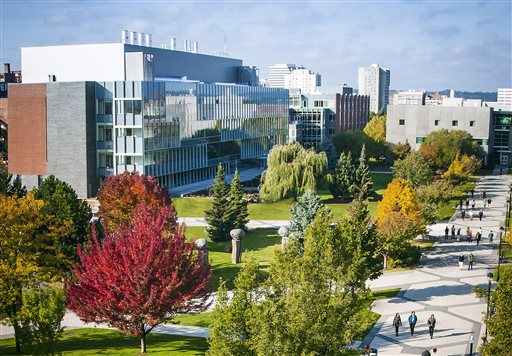Washington State University considers med school

In this Sept. 20, 2013 photo from Washington State University, medical students celebrate at a 'white coat ceremony,' where they move from pre-clinical to clinical studies, at the WSU campus in Spokane, Wash.

In this Sept. 4, 2013 photo, medical student Kacy Herron takes a patient history at Sacred Heart Medical Center in Spokane, Wash. Projecting a looming shortage of doctors in the state, Washington State is exploring the creation of its own medical school.

This Oct. 10, 2013 photo from Washington State University shows the new Pharmaceutical and Biomedical Sciences building, left, on the campus in Spokane, Wash. The $80 million, 125,000-square-foot building opened to students in January, 2014, and represents WSU's effort to create world-class facilities for preparing future healthcare professionals.



SPOKANE, Wash. >> Medical officials predict an aging population and expanded health coverage under the Affordable Care Act will contribute to doctor shortages across the nation. In response to the projected need, Washington State University has begun exploring the feasibility of opening a medical school on its Spokane campus.
“It’s clear we need more primary care physicians,” WSU president Elson Floyd said. The University of Washington has done a great job of putting doctors in the region, he said, but increasing demand in rural Washington state “is so great it may require two medical schools.”
UW has operated the WWAMI program for four decades, training doctors for Washington, Wyoming, Alaska, Montana and Idaho.
WSU has been affiliated with the program for years, but school officials say they may have outgrown it and cite doctor shortages in Eastern Washington that the program hasn’t addressed.
WSU’s feasibility study is due at the end of June, and Floyd thinks there is room for such expansion. “For states with our population, it is not unusual to have two medical schools,” he said.
Floyd is the former president of the University of Missouri system, which operates two medical schools.
Don't miss out on what's happening!
Stay in touch with breaking news, as it happens, conveniently in your email inbox. It's FREE!
The state of Missouri, similar in population to Washington, has a total of five medical schools admitting 500 total medical students per year, according to a WSU statement. UW admits 120 medical students from Washington per year, the statement read.
Doctor shortages are expected across the country as baby boomers age, physicians retire, and more people gain insurance through federal health care overhaul, said Christiane Mitchell of the Association of American Medical Colleges in Washington, D.C.
The association projects a shortfall of 91,500 doctors across the nation by 2020. The organization does not break down the expected shortages by state.
“Every baby boomer who became a doctor is about to retire,” Mitchell said.
To meet rising demand, states have been rushing to create more medical schools. There were 125 accredited medical schools in the U.S. in 2002. That number jumped to 141 this year, with more in the pipeline, the Association of American Medical Colleges said.
“States recognize the emerging access issues and want to be sure people can access doctors,” Mitchell said.
In recent years, WSU has been working with the UW School of Medicine to bring medical school training to WSU’s branch campus in Spokane.
There are about 40 total first- and second-year students in the program. But WSU officials think there is enough demand to justify enrolling classes of 80 students per year in a new school.
Randy Hodgins, UW vice president for external affairs, however, said the cheaper solution is to expand enrollment slots at the UW School of Medicine.
If it merely competes with the UW for scarce resources, “what problem would a new medical school solve?” Hodgins asked.
Expanding enrollment slots, as the UW is pursuing, would create new doctors cheaper and faster than creating a new medical school, Hodgins said.
He noted the state of Idaho recently considered starting a medical school at one of its universities but decided to remain in the WWAMI program.
“Does the state have the resources to start a brand new school from scratch, or is it better to invest in the one its already got?” Hodgins asked.
WSU leaders, however, say they would be more successful in producing primary care physicians interested in working in Washington state’s underserved rural areas.
“Most of our state looks more like Spokane and Eastern Washington,” areas that need improved physician access, Floyd said, adding that WSU’s desire for a medical school doesn’t need to strain relations between the state’s two research universities.
WSU would need permission of the Legislature to create a medical school. Determining how much it would cost and where that money would come from is part of the feasibility study.
Floyd said WSU has a donor base invested in medical education, and the school also has a new $80 million building designed to train doctors on its Spokane campus.
Washington State already operates schools of pharmacy and nursing in Spokane, where health care is the largest single sector of the economy.
Lisa Brown, chancellor of the WSU Spokane campus, said the WWAMI model has worked well, but needs to be adjusted to reflect the times.
Brown said that only 100 of the UW’s 1,600 residency slots in the state are located in Eastern Washington. A WSU medical school would place more residences on this side of the mountains, she said.
“If we want to grow more doctors in Eastern Washington,” she said, “we’ve got to grow more residencies in Eastern Washington.”



